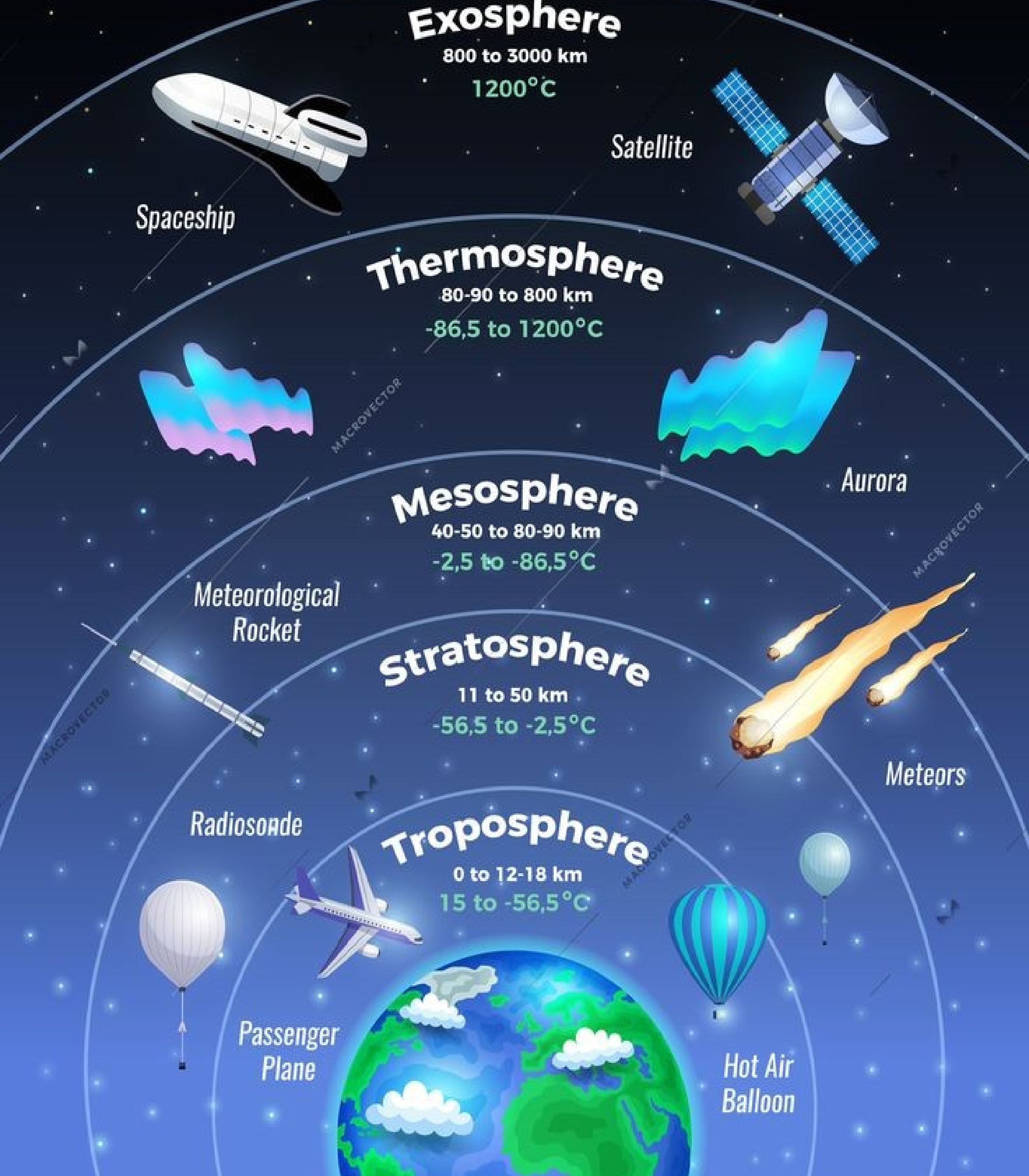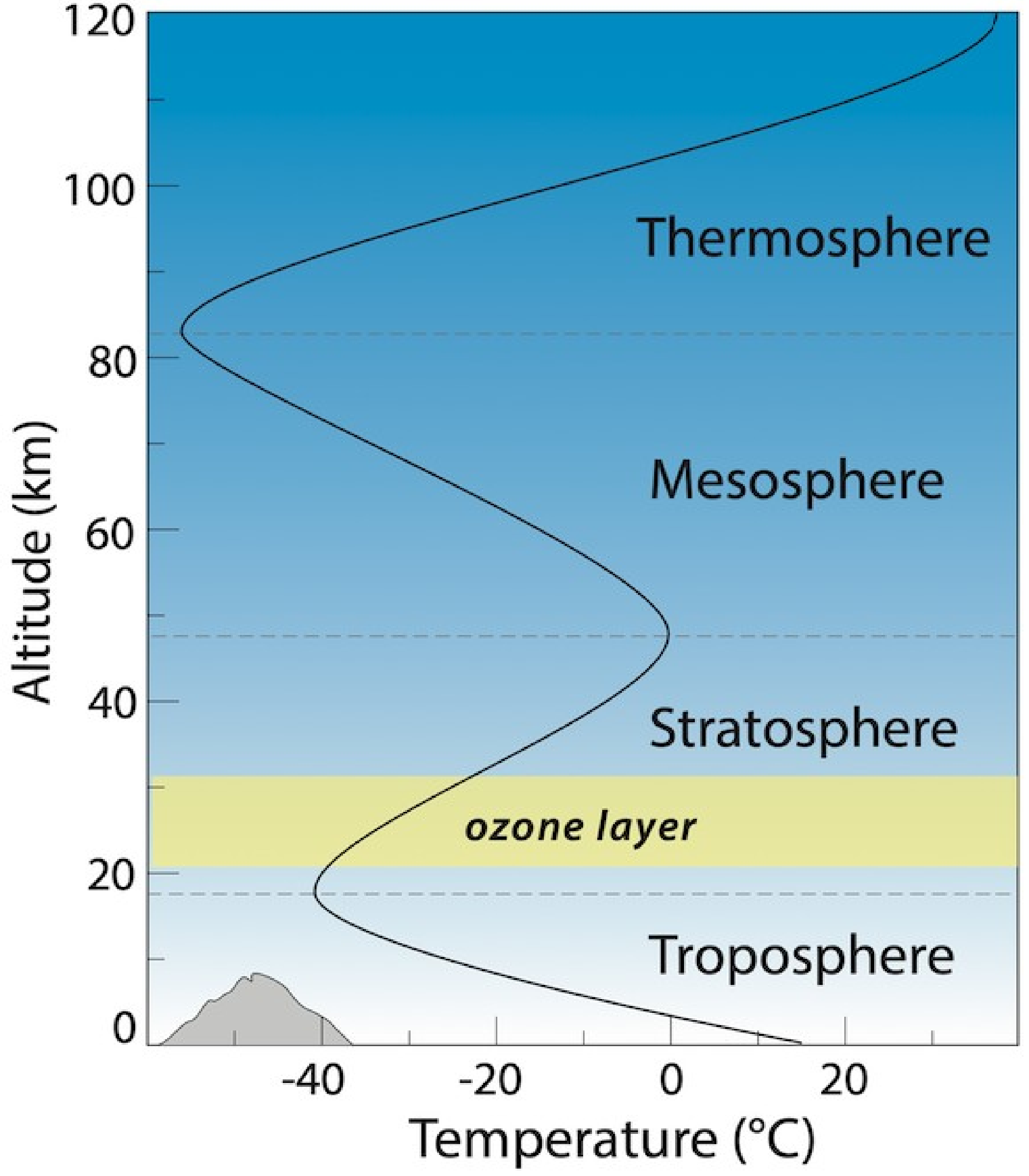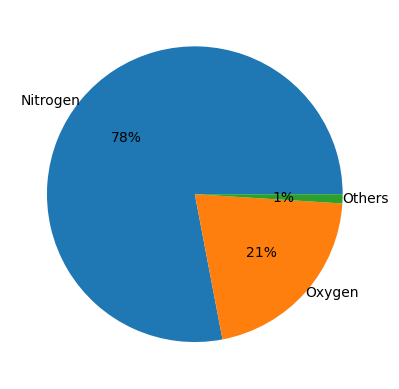Chapter 10 The Atmosphere
The atmosphere is the layer of gases [Figure 10.0.1.(a)] that surrounds our planet. The Earth’s atmosphere is composed of four main layers. The lowermost layer is the troposphere, which extends from the Earth’s surface to an altitude of about 8-15 kilometers. This is where all weather (such as clouds, rain) occurs, and it contains most of the Earth’s breathable air [Figure 10.0.1.(a)]. Above the troposphere is the stratosphere, which extends from about 15-50 kilometers above the Earth’s surface. This layer contains the ozone layer, which helps protect the Earth from the harmful effects of ultraviolet radiation from the Sun. Long distance flights (airoplanes and jets) fly in the lower level of this layer. Beyond the stratosphere is the mesosphere, which extends from about 50-85 kilometers above the Earth’s surface. This layer is where meteors burn up as they enter the Earth’s atmosphere. The outermost layer of the Earth’s atmosphere is the thermosphere, which extends from about 85 kilometers to the edge of space. This layer is characterized by very low air density but very high temperatures, and it is where the auroras occur and the space shuttle orbits. Atmosphere regulate the water cycle and whether conditioning on the earth. Thermosphere is also known as ionosphere as the solar radiation ionizes the upper atmosphere into ions and electrons. During sun storms ions of nitrogen and oxygen in the thermosphere produce beutiful aurora borialis in presence of earth magnetic field. Ionosphere makes long distance radio communication possible. Above the ionospher we have large regions of space with very thin gases we called the exosphere. But we do not include this layer in our discussion here.

atm Layer1
www.pinterest.ph/pin/741616263631151673/
Temperature & Pressure Profile2
www.visionlearning.com/en/library/Earth-Science/6/Composition-of-Earths-Atmosphere/107
The temperature profile of atmosphere is given in Figure 10.0.1.(b). In troposphere, temperature decreases with altitude and air is heated from the ground up. On average the atmosphere in this layer is slightly unstable. Generally, air density in the atmosphere decreases with increasing altitude. Troposphere has the most densly layer of air. In stratosphere, temperature increases with altitude. The temperature increases with altitude in the stratosphere because of the absorption of ultraviolet (UV) radiation by ozone \((O_3)\) molecules. The air density in the stratosphere is much lower than in the troposphere, and it decreases gradually with increasing altitude. In mesosphere, temperature decreases with altitude and air density is even lower than in the stratosphere, and it decreases rapidly with increasing altitude. In thermosphere, temperature is very dependent on solar activity. It is the layer of the atmosphere which is first exposed to the Sun’s radiation. In this layer, air density is extremely low, and it decreases exponentially with increasing altitude.
The Earth’s atmosphere is composed of a mixture of gases, including: Nitrogen \((N_2)\) - the most abundant gas in the atmosphere about 78%, Oxygen \((O_2)\) - the second most abundant gas in the atmosphere about 21%, Argon \((Ar)\text{,}\) Carbon Dioxide \((CO_2)\text{,}\) Neon \((Ne)\text{,}\) Helium \((He)\text{,}\) Methane \((CH_4)\text{,}\) and other trace gases usually less than 1% of the total volume. In addition to these gases, the atmosphere also contains variable amounts of water vapor \((H_2O)\text{,}\) that plays a significant role in weather and climate [Figure 10.0.1.(c)].
The pressure [Figure 10.0.1.(b)] in the atmosphere varies with altitude, temperature, and weather conditions. At sea level, the average atmospheric pressure is about 1013 millibars (mb) also referred as one atmosphere (1 atm) [eqn. (4.2.3)] of pressure. As altitude increases, atmospheric pressure decreases. This is because the weight of the air above decreases with increasing altitude. At an altitude of approximately 5.6 kilometers, the atmospheric pressure is about half of what it is at sea level. Temperature also affects atmospheric pressure. As temperature increases, the molecules in the air move faster and farther apart, which decreases the density of the air and, therefore, the atmospheric pressure. Similarly, as temperature decreases, the molecules in the air move slower and closer together, which increases the density of the air and, therefore, the atmospheric pressure. Weather conditions also affect atmospheric pressure. High-pressure systems are associated with clear, dry weather, while low-pressure systems are associated with cloudy, rainy weather. The movement and interaction of these high and low-pressure systems create weather patterns.
